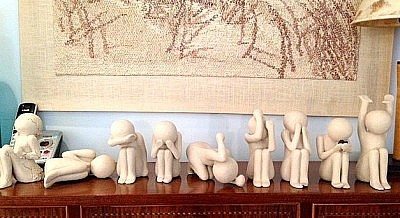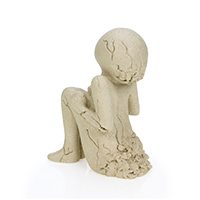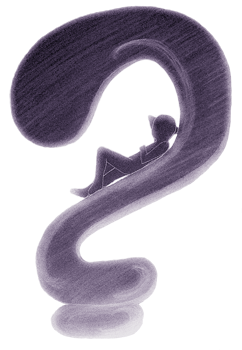 Back
Back
Testimonials
The following testimonials represent the opinions of professionals, clients and customers. Their reflections are appreciated so that others may know the value of using “The Little Guys” as experiential tools for self-discovery and healing.
What Others Are Saying...

“I bought one of the little guys many years ago and it has sat in the lap of so many clients and has even gone home with them periodically as a transitional object. So I was thrilled when Sheri developed a new set and I bought all nine of them. They are sitting on the desk in my psychotherapy office. When a client is experiencing a strong feeling I have them choose which of the poses feels right, have them hold the concrete object and talk about it. It has stimulated many dialogues (the angry one pounding the floor reminded a client of her adult child when she was younger and memories she never shared arose). The sculptures are evocative, beautiful and moving and feel so good in the hands.”
— LCSW - Private Practice
Working with Couples and People with Traumatic Histories
“The Little Guys have found their new home in my office! I LOVE them and they have been useful in my counseling practice. I encourage clients to hold the one that reflects their feelings; the quiet thoughtfulness of this process results in self refection and expression. They are so exquisite that they always cause a silent pause as the viewer takes in the depth of emotion. “
— Professional Clinical Counselor
Works with adults determined to work through barriers that stopped them in the past.
“(Using the sculptures) was very powerful with the group. Group members that ordinarily do not say much were able to put words with emotions. This will be a great spring board for further group!”
— BA/ RSW
Outpatient - Addictions and Dual Diagnosed

“Sheri’s ‘Little Guys’ have an honored and central place on my sand tray shelves. They are at once evocative and ambiguous, so they are ideal for a modality that relies on projections. From the first day they appeared in my office, they have been put into use by my clients — usually playing a starring role in their psychic dramas.”
— Ph.D. - Certified Imago & Sandtray Therapist
Couple's Counseling, Spiritual/Religious focus, Men and work issues, Depression and anxiety
“I believe these Little Guys have the potential to fill a hole in the area of diagnostic assessment of human emotions.”
— MA, CADC, PsyD
Private Practice
“(The Sculptures) facilitated children of addict to express their feelings in a safe way…. The client was able to understand more deeply how her addictive behavior impacts her children through their working with the sculptures.”
— M.A. CSAC II
Addictions Treatment
“I have the Little Guys on a mantel in a very prominent place in my office. They are conversation starters with colleagues and clients. Many times a client has been stuck — not sure how they feel. I have them pick a figure from the mantel. bring it back and describe the feelings of the figure to their partner. Often the partner has even looked at the figure and said “I wonder if you are not also feeling….” They are a marvelous tool for deepening affect in addition to being well made and very handsome.”
— M.Div., Certified Imago Relationship Therapist - Pastoral Counselor & Psychotherapist
Pastoral Center for Healing
“Kids can be willing to share their pain, but between sports and video games, it’s often difficult to start any deep conversations when you only see them for 15 minutes at a time. I acquired a set of the Little Guys, and one day just left them out on the table. The response from the teens was fascinating. Anyone walking past the table to get a snack had to stop and look, then HAD to pick up one figure after another. Everyone made comments about them, but my favorite was when one teen pointed to the Crumbling figure and said, “Yup, I know just how he feels.”
I think that is the real beauty of the Little Guys — that everyone can connect with at least one of them, and know that they are not the only one who has felt that way. The figures made it so easy to get some much needed “venting” and ultimately “healing” conversations started.”
— Therapist & Mom of Teenagers

“The ‘little guy’ that I purchased was Crumbling…. I immediately saw him as my reaction to growing older & fighting against it, but determined to make it better. The cracks indicated to me my arthritis and the pain, physical and emotional. This is my first week of retirement and I look at my little guy on my desk at home and repeat ‘I’ll do it!’ Thank you for him!”
— Customer
“…Personally, each time I experience (the art), I am challenged to look within myself and find more of who I am, and what my life purposes are.”
— MAADAC
Alcohol and Drug Abuse Counselor
“I have been in a therapist support group for some time. I took the little guys there to show the group…. One member had to have a serious operation. She was quite fearful about it. I ‘loaned’ her two guys to take to the hospital with her. She chose ‘abandoned’ and the one with the butterfly (heart). She kept them throughout her hospital stay and was comforted by having them with her.”
— MFCC - Psychotherapist
“I believe that the reason we relate so well to your ‘little guys’ is because our feelings represent the ‘little guy’ a.k.a. the child in each of us, that needs to be nurtured, but is so often neglected. Thank you for helping me get back in touch with my own ‘little guy’, for giving us the tools, for helping others find theirs, and for the opportunity to experience true intimacy. Always one to concentrate on the ‘up’ side, and to choose to be alone rather than remain in a bad relationship, I didn’t realize how much pain the ‘aloneness’ left inside of me- My experience with your ‘little guys’ left me feeling ‘born again’, with so much more to give, and so much to receive from others….”
— Professional Conference Attendee
The Fine Art of Feelins Experietal Workshop Participant
“Our church hosts many outside “self-help” groups such as Weight Watchers, AA, Divorce Recovery, etc. One year we held a weekend retreat with all the groups. The facilitator was an Art Therapist who brought her whole set of the “Little Guys” (which most of us had never seen), along with several instant Polaroid cameras. She asked us each to take a picture of the figure we most identified with, and then bring the photo back to our individual groups to discuss. Some women took a while to decide which figure was best for them, while others zeroed in almost immediately on one.
The afternoon was most interesting and helpful, as we shared our photos with each other, and talked about why we had chosen our particular figure. In some cases, the person didn’t even know why she connected with a certain form, until she started talking about it.
It was quite remarkable was when several people had chosen the same figure, but “saw” completely different emotions. For example, one figure has its hands in front of its face. One person saw the figure as “afraid to look at the future”, another saw it as “shy and insecure,” while yet another saw it as giggling, and holding its hands up to “hide its smile”.
The survey comments at the end of the retreat were very positive, and several suggested they use the “Little Guys” at the next men’s retreat.
These simple, yet powerful little figures proved to be truly memorable. Years after this retreat, the women I spoke with had all still kept their little photos. One woman had chosen the figure with the arms upraised. At that time, she said she felt like she was “carrying the weight of the world” on her shoulders. After time passed though, and she had done the inner work needed to heal, she says when she looks at the photo now, the figure is holding its hands up in victory.”
— Church Program Coordinator
“I love the 3 ‘little guys’ my husband bought for me as a gift. They are perfect, and have a home in my private practice office. I practice psycho dynamic object relations therapy, and also use Gestalt technique where applicable….I use the sculptures as part of my environment and let the patient direct their responses….Almost all of them responded favorably to the little guy’s appearance in the office. None of them reacted in a way that became a part of the session and I have not used them in this way…. I do think that they help provide a safe and open message by their presence.”
— M.ED, NBCC, AAMFT
Private Practice
“I feel like these objects made lots of sense because they reach out and touch your inner-self, feelings. I think that these objects are very good when dealing with people and how they express their feeling or inner-self.”
— Client
“In working with the (abandoned) figure, I shifted from feeling ashamed and frightened about being abandoned to experiencing ‘abandonment’ as a part of me to be nurtured and accepted.”
— LMSW
Eating Disorder Professional
“I have been showing my Little Guys to everyone, everyplace! What amazing reactions! My parents’ comments have been almost funny – my mom has some dementia, and she saw the “rage” figure as holding its head and saying, “WHERE did I PUT that!” My dad (who can’t lift his arms anymore from a botched surgery) said, “At least he can wash his hair!”
— Daughter
Caring for Aging Parents
“This particular client…was drawn to the ‘little guys’. I had not introduced them to her in therapy session, but she saw them in my office and requested interaction with them. In other sessions with other clients, I have introduced the sculptures with specific intent and also received positive results. During (another) session a client was extremely upset. I introduced the sculptures to the client. The client was able to select one sculpture which seemed to provide a sense of relief and comfort……Also enhanced the client’s sense of success in feeling as though he/she could communicate and connect with me.”
— LMSW - ACP, BCP
Depression / Anxiety Treatment - Private Practice
“The collection enabled me to see that there are many feelings we feel. And that most of them are normal. I learned that it is O.K. to feel a certain way. I learned that it is not good to dwell on a feeling, learn to express (the feeling) and move on. The collection allows us to show how we feel when words are hard to find. They are an ice breaker for most. They are an inspiration to remind us about the other feelings we may not know, and therefore encourage us to seek the feeling out. I think they would be great for children also.”
— Client
“At a workshop in N.Y. City I used an exercise combining the Little Guys with the qualities of the sefirot in the Kabbalist Tree of Life System. The workshop concerned an integration of the 12 steps with the Tree of Life and Jacob’s Ladder. The Little Guys were powerfully evocative and relate very well to special ‘placingS’ on the Tree. I intend to use the same type of exercise in the future at other workshop around the country. Participants were very responsive and interested in working further with the Guys.”
— M.S.
Psychology and Spiritual Professor
I teach English to adults from countries all over the world. Some have come to America looking for a better job, while others have come to escape terrible situations. All have different fears and insecurities, and all are homesick.
For our conversation time in class, we are always looking for simple, clear pictures that they can describe with their new, limited English words. Usually we use pages torn out of magazines, but it’s difficult to find photos that they can all relate to. For example, a bride & groom from an American magazine look very different than a bride from India or Africa.
However, when I saw the Little Guys, I knew they would be PERFECT for our classes, and they are! The universal emotions of fear, joy, embarrassment, loneliness, etc. are easily understood by all. The students are so eager to hold them, and with heads vigorously nodding, they will say, “Yes! I feel like THEESE one!”
My students love the Little Guys, and so do I!
— ESL Teacher
City of Chicago
“It is this clinician’s opinion that the use of the Interactive Art (The Little Guys) can be a useful and powerful way to evoke ‘here-and-now’ experiences in group therapy for all age groups and functioning levels in a psychiatric setting and can be one tool that can be used in psychiatric impatient setting when clinically appropriate…”
— Clinical Supervisor
Behavioral Health Center
“…it helps adolescents/children project issues into sculpture as well as externalize thoughts and feelings for discussion and role playing where trust and disclosure are difficult.”
— CTRS
Inpatient Psychiatric Unit
“Use of these sculptures has been very exciting. Some clients come into my office and will notice the sculptures immediately, but not comment at that time. However, there is always a comment two or three weeks later. I am finding that the clients’ own ability to use this form of experience through their own sort of timing is very valuable and productive. …I have numbered the sculptures and as a client identifies a feeling related to one of the sculpture, I record the number and track their feelings in this way week by week. The client and I may then go over this after a period of time – works as a wonderful metaphor for clients to see their own progress.”
— LMSW - ACP, BCP
Children & Adolescence Therapy
“The sculptures helped free me from Self-Imposed exile. I am able to express my feelings and, more important, own my feelings.”
— Client


